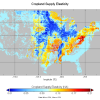Gridded Cropland Supply Elasticity for the Continental United States (5 arc-min Spatial Resolution)
This dataset includes empirically estimated cropland supply elasticities for more than 75,000 grid cells over the continental United States calculated for years around 2010. The data is provided in NetCDF, GeoTIFF, CSV, and HAR file formats.
Additional materials available
Version 1.0 - published on 01 Jun 2023 doi:10.13019/37T9-0E88 - cite this
Licensed under these terms
Description
Data items include empirically estimated cropland supply elasticities for more than 75,000 grid cells over the continental United States calculated for years around 2010. Supply elasticity is an economic concept demonstrating the response of suppliers to changes in prices given everything else is constant. In terms of cropland supply elasticity, it shows the response of cropland supply to a 1% change in rents (returns) in a given location and given time keeping everything else constant. A high cropland supply elasticity implies that a small increase in rents is sufficient for a large increase in land supply, while a low cropland supply elasticity entails that a large increase in land rents is required to motivate increases in cropland supply.
The data is provided in NetCDF, GeoTIFF, CSV, and HAR file formats. The spatial resolution is 5 arc-min. An arcminute is 1/60th of a degree. A 5 arc-minute resolution is 1/12th of a degree and equivalent to squares with the side 9.26 km at the Earth's equator. The spatial resolution is 5 arc-min sufficient for many land use studies, such as land cover mapping, vegetation monitoring, and agricultural policy assessment.
This dataset is developed to provide insights into the magnitude of likely responses of cropland to regional and global changes. It is valuable for potential use in quantifying the overall agricultural economic responses and land use changes to economic and environmental drivers. The proposed land supply elasticities have been used in studying the impact of global changes on local land and water resources. They are also used in investigating the local responses to global and local changes. The gridded land supply elasticity parameter is important for spatial economic research in agriculture. It is the major factor for analyzing the spatially heterogeneous responses of farmers to agricultural policies and shocks. It is also important for understanding the spatial distribution of the impacts of climate change on agriculture.
The elasticities are validated for predicting aggregate cropland changes in the United States. We do not recommend the data for studying individual grid cells. Special considerations and further economic estimations are required when focusing on individual grid cells. For technical details about estimating the land supply elasticities for the Americas, based on accessibility, refer to Villoria and Liu (2018), for the US land supply elasticities, refer to Villoria, Chakravarty, and Delgado (2020), and Villoria et al (2022).
For more details about the version 1.0.0 look at:
Villoria, N. B., & Liu, J. (2018). Using spatially explicit data to improve our understanding of land supply responses: An application to the cropland effects of global sustainable irrigation in the Americas. Land Use Policy, 75, 411-419. https://doi.org/10.1016/j.landusepol.2018.04.010
For more details about version 2.0.0 look at:
Villoria, N. B., Cisneros-Pineda, A., Haqiqi, I., Chakravarty, S., Delgado, M., & Hertel, T. W. (2022). Heterogeneous land supply responses in US agriculture: Exploring changes in land use from reductions in biofuel mandates. 2022 Annual Meeting, July 31-August 2, Anaheim, California 322315, Agricultural and Applied Economics Association. 10.22004/ag.econ.322315
Chakravarty, Shourish & Villoria, Nelson B., (2020). "Estimating the spatially heterogeneous elasticities of land supply to U.S. crop agriculture," Conference papers 333156, Purdue University, Center for Global Trade Analysis, Global Trade Analysis Project. https://ageconsearch.umn.edu/record/333156
For an example of application, look at:
Baldos, U.L.C., Haqiqi, I., Hertel, T.W., Horridge, M. and Liu, J., (2020). SIMPLE-G: A multiscale framework for integration of economic and biophysical determinants of sustainability. Environmental Modelling & Software, 133, p.104805, https://doi.org/10.1016/j.envsoft.2020.104805
Acknowledgments
The authors acknowledge support from the United States Department of Agriculture AFRI Grant #2019-67023-29679: 'Economic Foundations of Long Run Agricultural Sustainability'; and the National Science Foundation INFEWS award #1855937: 'Identifying Sustainability Solutions through Global-Local-Global Analysis of a Coupled Water-Agriculture-Bioenergy System'; and the National Science Foundation OISE award # 2020635: 'AccelNet- GLASSNET: Networking Global to Local Analyses to Inform Sustainable Investments in Land and Water Resources'.
Content List ( Show bundle contents ) Bundle
Bundle(ZIP | 2 MB)
Gridded_Cropland_Supply_Elasticity_CONUS_v1.0.0.pdf(PDF | 356 KB)
- License terms
Cite this work
Researchers should cite this work as follows:
- Villoria, N., Liu, J., Haqiqi, I., Shourish Chakravarty, Delgado, M., Cisneros-Pineda, A., Hertel, T. (2023). Gridded Cropland Supply Elasticity for the Continental United States (5 arc-min Spatial Resolution). MyGeoHUB. doi:10.13019/37T9-0E88
Tags
Notes
This version includes v.1.0.0 and v2.0.0 datasets based on the improved statistical model.
glassnet
This publication belongs to the glassnet group.

